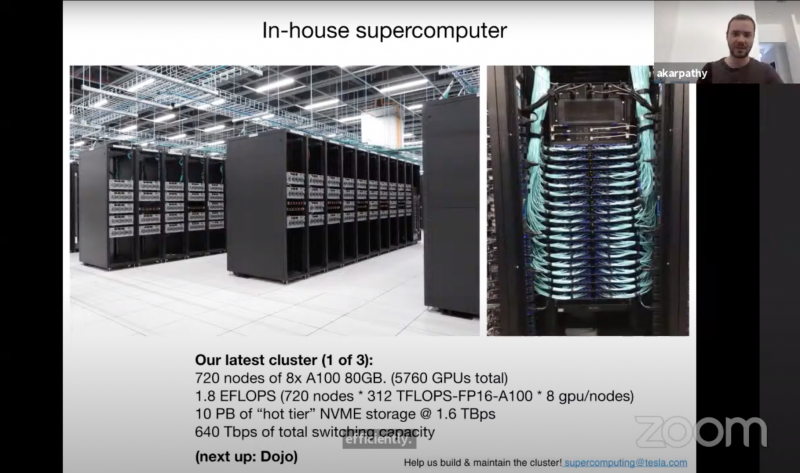To tackle one of the greatest computing challenges ever, Tesla will need unprecedented computing power.
At this week's CVPR (International Conference on Computer Vision and Pattern Recognition), Andrej Karpathy, senior director of AI at automaker Tesla, unveiled the company's internal supercomputer for training deep neural networks for Autopilot and autonomous driving. The cluster uses 8 NVIDIA A100 Tensor Core GPUs with 720 nodes (a total of 5,760 GPUs) to achieve a super-strong performance of 1.8 exaflops.
Karpathy said: "This is an excellent supercomputer. In terms of FLOPS, it is probably ranked fifth among supercomputers in the world."
By putting unprecedented levels of computing power in the automotive industry at the core of its research and development cycle, Tesla is enabling its self-driving car engineers to use cutting-edge technology to do this work efficiently.
NVIDIA A100 GPUs provide acceleration at all scales for the world’s most powerful data centers. Built on the NVIDIA Ampere architecture, the A100 GPU delivers 20 times the performance of the previous generation and can be partitioned into seven GPU instances to dynamically adapt to different needs.
Using (data from) more than one million cars on the road to continuously optimize and iterate new features is Tesla's vertical integration approach to autonomous driving, and GPU clusters are part of it.
From cars to data centers
Tesla’s iterative development process starts with the car, where “shadow mode” silently executes perception and prediction deep neural networks (DNNs) without actually controlling the vehicle.
Any mispredictions and misidentifications are recorded, and these instances are then used by Tesla engineers to create a training dataset containing a variety of complex scenarios to improve the DNN.
Currently, 1 million 10-second clips recorded at 36 frames per second have been collected, with a total data volume of up to 1.5PB. In the data center, Tesla puts the DNN into these scenarios and runs them repeatedly until the DNN can run without errors. Finally, the DNN is sent back to the car and the next cycle begins.
Karpathy said that training DNNs on such large amounts of data in this way requires massive computing power, and Tesla built and deployed the latest generation of supercomputers with built-in high-performance A100 GPUs for this purpose.
Continuous Iteration
In addition to full-scale training, Tesla's supercomputers provide autonomous vehicle engineers with the performance they need to experiment and iterate during the development process.
Karpathy said that the DNN structure currently deployed by Tesla allows a team of 20 engineers to work on a network at the same time, enabling parallel development by isolating different functions.
These DNNs can run through training datasets even faster than before when they were rapidly iterating.
“Computer vision is fundamental to everything we do and is key to making Autopilot possible,” Karpathy said. “To do this, we have to train a huge neural network and do a lot of experiments. That’s why we invest a lot in computing power.”
Previous article:How to create faster, safer and smarter charging stations
Next article:Volvo and Ericsson achieve seamless cross-border 5G connectivity for autonomous vehicles
- Popular Resources
- Popular amplifiers
- A new chapter in Great Wall Motors R&D: solid-state battery technology leads the future
- Naxin Micro provides full-scenario GaN driver IC solutions
- Interpreting Huawei’s new solid-state battery patent, will it challenge CATL in 2030?
- Are pure electric/plug-in hybrid vehicles going crazy? A Chinese company has launched the world's first -40℃ dischargeable hybrid battery that is not afraid of cold
- How much do you know about intelligent driving domain control: low-end and mid-end models are accelerating their introduction, with integrated driving and parking solutions accounting for the majority
- Foresight Launches Six Advanced Stereo Sensor Suite to Revolutionize Industrial and Automotive 3D Perception
- OPTIMA launches new ORANGETOP QH6 lithium battery to adapt to extreme temperature conditions
- Allegro MicroSystems Introduces Advanced Magnetic and Inductive Position Sensing Solutions
- TDK launches second generation 6-axis IMU for automotive safety applications
- LED chemical incompatibility test to see which chemicals LEDs can be used with
- Application of ARM9 hardware coprocessor on WinCE embedded motherboard
- What are the key points for selecting rotor flowmeter?
- LM317 high power charger circuit
- A brief analysis of Embest's application and development of embedded medical devices
- Single-phase RC protection circuit
- stm32 PVD programmable voltage monitor
- Introduction and measurement of edge trigger and level trigger of 51 single chip microcomputer
- Improved design of Linux system software shell protection technology
- What to do if the ABB robot protection device stops
- Learn ARM development(19)
- Learn ARM development(14)
- Learn ARM development(15)
- Analysis of the application of several common contact parts in high-voltage connectors of new energy vehicles
- Wiring harness durability test and contact voltage drop test method
- From probes to power supplies, Tektronix is leading the way in comprehensive innovation in power electronics testing
- From probes to power supplies, Tektronix is leading the way in comprehensive innovation in power electronics testing
- Sn-doped CuO nanostructure-based ethanol gas sensor for real-time drunk driving detection in vehicles
- Design considerations for automotive battery wiring harness
- Do you know all the various motors commonly used in automotive electronics?
- [RISC-V MCU CH32V103 Review] Tick Timer
- 5G WiFi can save some energy
- [ACM32F070 supporting capacitive touch development board to evaluate the basic functions of UART serial port]
- Choosing the right GaN power amplifier - the design is so simple
- The Perseverance rover landed on Mars. Let’s talk about how demanding space is on equipment.
- Infineon Angle Sensor Application Unlocking Machine See how many you can find? Good gifts are waiting for you!
- FPGA experience talk (Xi'an Datang Telecom).pdf
- EEWORLD University ---- ST MEMS sensor application demonstration video
- Analog Discovery 2 review
- What is the purpose of connecting a 10uF capacitor after the op amp output?




 LT6203IMS8#TR
LT6203IMS8#TR














 京公网安备 11010802033920号
京公网安备 11010802033920号